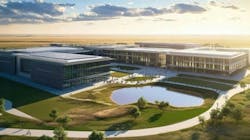Planned Texas AI Data Center Project Gains First Approval for Off-Grid Gas Power
An off-grid data center power developer co-founded by former U.S. Energy Secretary Rick Perry took the first step toward clearing its first regulatory hurdle in Perry’s home state of Texas.
The Texas Commission on Environmental Quality (TCEQ) has preliminarily approved plans for an initial 6 GW in off-grid natural gas power for the HyperGrid campus near Amarillo.
Fermi America is promising to build as much as 11 GW of artificial intelligence and digital infrastructure capabilities within the Project Matador HyperGrid campus. The first phase could deliver about 600 MW of gas-fired power.
Although the TCEQ approval still requires public input and formal commission authorization, it nudges the HyperGrid planning one more step toward development of off-grid natural-gas fired electricity generation to power AI-enabled data centers.
"Hardworking Americans are tired of watching electricity costs rise while the grid ages," added Toby Neugebauer, CEO and co-Founder of Fermi America. "At Fermi, our private grid model ensures that the growing demand for AI is met privately — freeing up power on the public utilities to serve homes, schools, hospitals, and small businesses as intended. Together with our partners, we're building one of the cleanest, most efficient power fleets in the world, driven by American innovation — without asking taxpayers to foot the energy bill for the world's largest, highest-margin companies."
Whether it becomes a reality or not, the Fermi America HyperGrid project addresses a key challenge for meeting future load from AI and data centers—the specter of utility-scale service for private industry at the expense of or to the exclusion of residential customers. Many opponents criticize the potential expense of power purchase agreements designed to favor big tech companies, they say. This opposition and the desire for investment to speed projects is behind power purchase agreements by companies such as Meta, Microsoft, Google and others.
Another challenge is the long interconnection queues to bring distributed energy and power plants into the utility grid—sometimes as long as three to five years. Developing on-site or co-located direct current and off-grid projects could alleviate some of that utility-scale strain.
The proposed first phase of the Amarillo HyperGrid plans to connect six Siemens Energy SGT800 gas-fired turbines and one SST600 steam turbine to deliver about 478 MW of co-located and combined heat and power for the proposed AI campus in the Texas Panhandle.
Fermi America was co-founded by a team that includes American private equity investor Neugebauer and Perry, who was the energy secretary in President Donald Trump’s first administration and also Texas governor from 2000 to 2015. The company is named after Italian physicist Enrico Fermi, who played a significant role in the Manhattan Project to develop nuclear power during World War II.
Although gas-fired power is the initial behind-the-meter power solution for the planned Amarillo HyperGrid, Fermi America reportedly will also seek federal Nuclear Regulatory Commission (NRC) approval to build utility-scale reactor plants alongside the Amarillo AI site.
Fermi America also reportedly plans to integrate zero emissions solar into its power supply plan and utilize the latest technology and hybrid cooling systems to protect air quality and water conservation, the company says.
A recent report by Goldman Sachs predicts that data center energy demand will surge 160% by 2030. Other industry research firms such as Rystad Energy are anticipating between 100 and 125 GW of new data center capacity coming online over the next 10 years.
About the Author
Rod Walton, EnergyTech Managing Editor
Managing Editor
For EnergyTech editorial inquiries, please contact Managing Editor Rod Walton at [email protected].
Rod Walton has spent 17 years covering the energy industry as a newspaper and trade journalist. He formerly was energy writer and business editor at the Tulsa World. Later, he spent six years covering the electricity power sector for Pennwell and Clarion Events. He joined Endeavor and EnergyTech in November 2021.
Walton earned his Bachelors degree in journalism from the University of Oklahoma. His career stops include the Moore American, Bartlesville Examiner-Enterprise, Wagoner Tribune and Tulsa World.
EnergyTech is focused on the mission critical and large-scale energy users and their sustainability and resiliency goals. These include the commercial and industrial sectors, as well as the military, universities, data centers and microgrids. The C&I sectors together account for close to 30 percent of greenhouse gas emissions in the U.S.
He was named Managing Editor for Microgrid Knowledge and EnergyTech starting July 1, 2023
Many large-scale energy users such as Fortune 500 companies, and mission-critical users such as military bases, universities, healthcare facilities, public safety and data centers, shifting their energy priorities to reach net-zero carbon goals within the coming decades. These include plans for renewable energy power purchase agreements, but also on-site resiliency projects such as microgrids, combined heat and power, rooftop solar, energy storage, digitalization and building efficiency upgrades.

